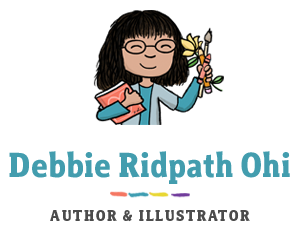[Edited December 14, 2018: I created this post because it’s the kind of personal viewpoint I was hoping to find while researching for my own eye surgery. Please note that every situation is different – talk to a medical expert before making your own decisions. I am NOT a medical expert.]
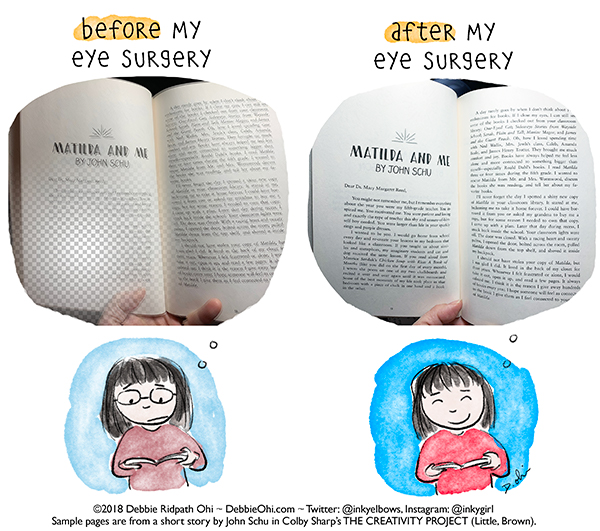
I’ve never had the best eyesight, and have worn glasses for as long as I can remember.
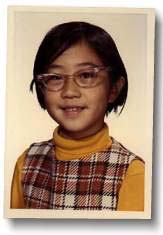
I have no memory of when I first got my first pair of glasses, though I do recall always feeling a “aha! awesome” moment each time I upgraded to a new prescription and was able to see the world clearly for the first time in a long while.
I went through this experience again, for a different reason. Up to five days ago, here’s what it was like for me to read a print book (right eye vision) WITH prescription glasses:
Excerpt from a story by John Schu in Colby Sharp’s THE CREATIVITY PROJECT (Little, Brown).
Without glasses, here’s what it looked like:

And now, three days after my eye surgery, WITHOUT glasses:
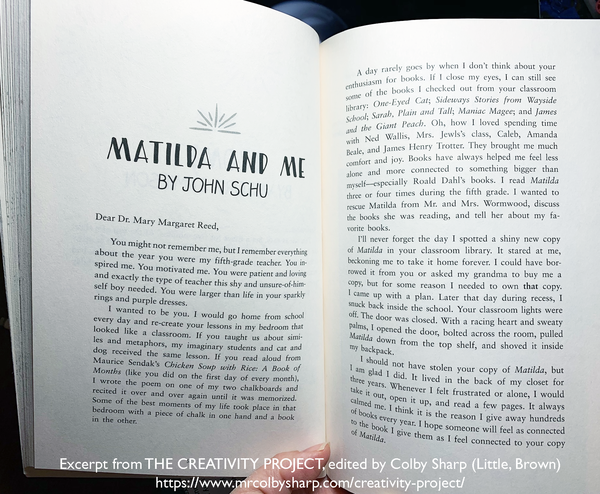
You can’t really tell from the low-res image above, but I am now delighted to announce that I could see the above pages with 100% CLARITY. My eyes were feasting; it was truly DELICIOUS.
I still need distance glasses and once my vision settles post-surgery, may opt for progressive lenses so I don’t have to keep putting on and taking off my glasses. Please note that whether this happens for you post-surgery will depend on the type of lens you choose and also your own recovery situation.
Some more background – Despite my poor eyesight throughout my life, I never considered LASIK surgery (note: I did not have LASIK surgery on Monday, just mentioning it here)…partly because of the cost but mostly because I was worried about something going wrong. Plus I honestly don’t mind glasses at all – I’ve had them most of my life. I did try wearing soft contact lenses for a couple of years in high school but never got used to them; I hated touching my eyes. I eventually switched back to glasses.
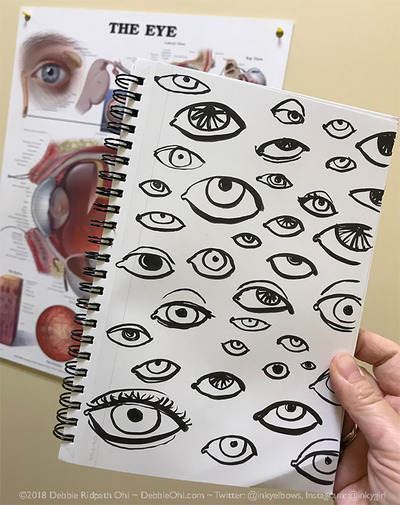
WHY I EVENTUALLY NEEDED EYE SURGERY:
Fast forward to a couple of years ago, when I noticed an odd little distortion in the lower left field of vision in my right eye when I was out walking in bright sunshine. I couldn’t look directly at it, but could tell something was a bit odd. It was like a little shimmer of heat haze, except I recall it wasn’t all that warm that day.
I also kept taking off my glasses to clean them because I noticed what I thought was a smear….but couldn’t see any smear on the glass.
Over time, I found it more difficult to see my computer screen, and kept needing new eyeglass prescriptions. My optometrist sent me for tests. My friend who did the visual field test did notice something odd about my results.
It turned out that I had a tiny cataract in my right eye.
As soon as I heard the word “cataract,” I was shocked. A CATARACT? I had always assumed that cataracts only affected those in later stages of life, not someone in her fifties (I used to think this was old but my definition of “old” shifts as I get older). I did some research and found that cataracts are usually age-related but sometimes occur at younger ages, and can even affect infants and young children.
I nicknamed my cataract Igor. Igor was growing very slowly, I was told. My optometrist advised me to hold off cataract surgery for as long as possible, that there was no sign (yet) of a cataract in my left eye.
My colour perception in my right eye was different from my left….more faded, more yellow.
Igor kept growing, and I noticed double vision in my right eye. The heat-shimmer distortion had turned into a much larger area that was….nothing. So hard to describe. Just before my cataract surgery, I attempted to create an image that showed what I was seeing out of my right eye. For those not familiar with Photoshop, the little squares represent a transparent layer mask; in the case of my vision, this was the “nothingness” I’m talking about:
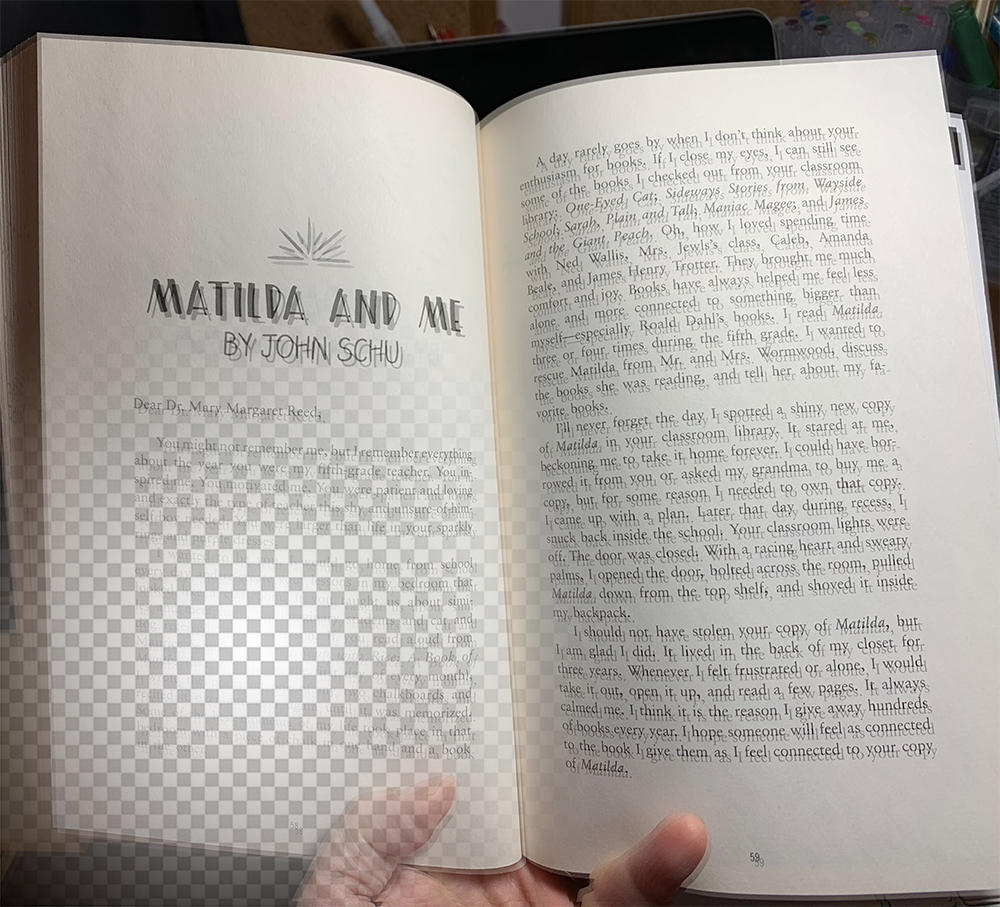 Excerpt from a story by John Schu in Colby Sharp’s THE CREATIVITY PROJECT (Little, Brown).
Excerpt from a story by John Schu in Colby Sharp’s THE CREATIVITY PROJECT (Little, Brown).
I tried my best to be as accurate as possible, to not exaggerate anything. It was difficult, trying to recreate a visually-impaired experience while still experiencing the visual impairment!
Note also the lack of contrast in the image above. I did find this was more and more of a problem, especially affecting my depth perception. I found it an increasing challenge to see things and people that were right in front of me.
Clearly, IGOR HAD TO GO.
When Jeff and I arrived at our friends’ house for dinner one night several months ago, I managed to trip over the base of their staircase because I was unable to differentiate the floor from the first step. Embarrassed, I confessed to our friend about my cataract, and that I was considering surgery.
Turns out that our friend was a specialist in cataract surgery in Toronto! We talked about my situation, set up some appointments and he ended up doing my eye surgery. An aside: I highly recommend Dr. John Lloyd and his team; he works with Sunnybrook Hospital, the Kensington Eye Institute and LasikMD Toronto.
Originally I was going to have my surgery in September 2019 but decided that I didn’t want to wait that long. Working was becoming more of a challenge; I was having to take frequent breaks to avoid headaches, and any kind of visual work took a toll. When using my DSLR camera, I could no longer use my right eye to look through the viewfinder because it was blurry. I relied heavily on auto-focus.
So I decided to book surgery through Dr. Lloyd’s private practice via Lasik MD in Toronto. Instead of September 2019, my surgery date was December 10th, 2018.
CHOICES TO MAKE BEFORE MY EYE SURGERY (added this section December 14, 2018):
Once I decided to go ahead with surgery, I had several consultations and pre-op tests with Dr. Lloyd and his team. In addition to all kinds of measurements, they also asked me about my daily activities and my expectations from the surgery. Did I drive? Did I do a lot of outdoor sports? (answers to both: no). What were my main work activities? What hobbies? There were several types of IOL (intraocular)lenses to choose from. At first, I assumed that I should go for the “top of the line,” if I could afford it — a Multifocal IOL which (in theory) would let me see clearly at all distances without glasses. However, in the end, I opted to keep some of my nearsightedness and chose a Monofocal IOL instead.
I won’t attempt to explain why since I’m sure to botch up the medical bits, but in my situation it made the most sense and was the least risky. It meant that I would have sharper vision for computer work and reading, but would need glasses for distance. As I mentioned earlier, I don’t mind glasses at all and in fact, would feel weird without them. My astigmatism would also be corrected with this type of lens.
THE SURGICAL PROCESS
In many cases, patients do one eye at a time, waiting at least a few weeks between eyes. I suppose the thought is that if anything goes wrong with the first surgery, at least the patient has vision left in the other eye. I decided to have both eyes done at once. I wanted to get it all done at once, plus I knew that if I only had one eye done at a time, the weeks between surgeries would be a challenge with my lopsided vision. I’m lucky in that Jeff was take some time off work plus work from home for a few days, so would be able to care for me immediately after surgery.
Please note, however, that every situation is different, and that it may be riskier for some people to do both eyes at once. Again, I emphasize that you should talk a medical expert who is familiar with your own situation before making the decision.
As for the cataract surgery, the surgeon basically 1) creates a tiny incision in the eye, 2) uses ultrasound to remove the old lens (and cataract?), (3) inserts the foldable artificial lens through the incision created in step #1, (4) new lens unfolds. More details on this page from the Lasik MD page. And again, I’m sure I botched the explanation so please don’t quote me. 🙂
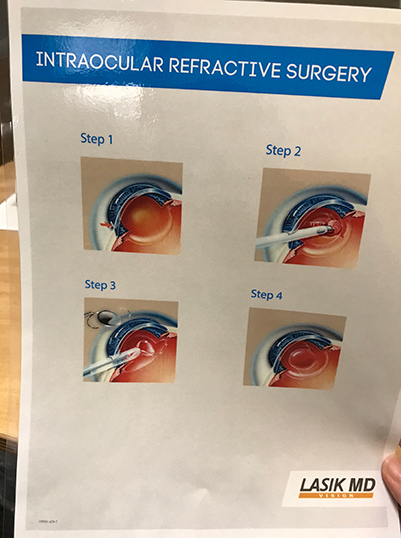
WHAT HAPPENED ON THE DAY OF SURGERY:
Jeff drove me for my noon appointment. Although my initial consultation was in LASIK MD’s downtown location and one of the pre-op tests was in their North York location, the actual surgery was in their Mississauga location.
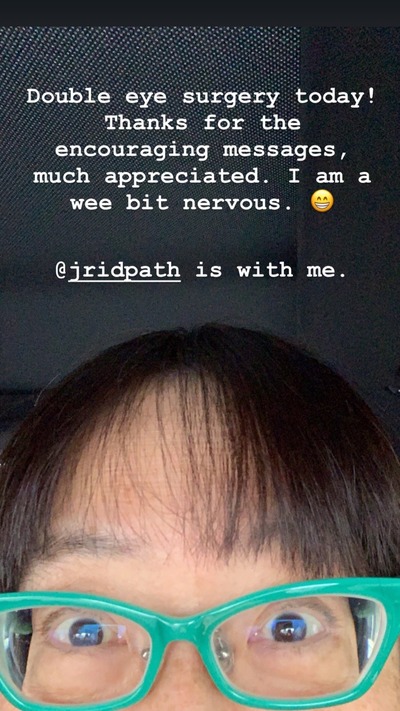
After checking in, Jeff and I sat for a short time in their waiting room. There were others in the room as well, some couples and one fellow waiting with wraparound sunglasses. I was called into one of the offices (Jeff came with me) where I signed a bunch of permission forms, paid my fee via credit card, had some dilating drops put in my eyes. Heads-up: if you’re doing eye surgery, be prepared for a LOT of eyedrops, both before, during and after the surgery!
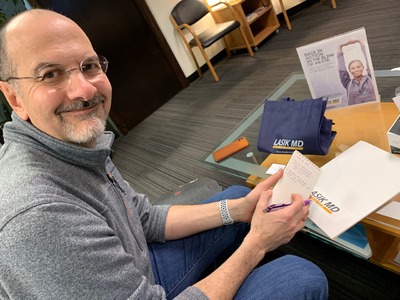
Another short wait and then I was called into one of the operating rooms where Dr. Lloyd looked at my eyes and we had our final pre-op chat about what was going to happen as well as post-op care, and I had a chance to ask any last questions before the surgery. Then I was given a tiny blue pill with a cup of water; I knew the pill was to help relax me for the procedure. I hoped it was strong!
I was called into another room where I was given a paper surgical cap to keep my hair out of my face, paper covers for the bottom of my boots. I didn’t have to change clothes…I had already been instructed to come to the surgery wearing something comfortable but also to avoid anything that might shed lint in the surgical area (e.g. avoid fleece). That morning, I had discovered most of my extra layers are fleecy or give off lint! I ended up settling on a long blue sweater that my sisters-in-law had helped me buy when we visited Stratford together; I told them later it was also like having them there with me. 🙂
Me, about to have double eye surgery!
Speaking of my sisters-in-law (both of whom texted me), thanks to those of you who sent supportive texts and messages the morning of my surgery! I was freaking out a little bit, so they helped a great deal. But I digress….
Shortly after I got my paper cap and booties, I was ushered into the operating room. It looked very hospital-like and as I stepped on the stool to lie down on the padded operating table, I remember thinking, When is the pill going to start working? I feel the same! They’re not going to start operating before the pill kicks in, are they? I didn’t say anything out loud, though, because Dr. Lloyd had reassured me earlier that the pill would start working before the surgery began, so not to worry.
And he was right. Even as I lay down and given more drops (including numbing drops), I could tell that something was different. I felt a tad loopy, a bit off-kilter….but in a good way. My face was draped with a protective sheet, and I could sense the bustle of activity begin.
The calming pill definitely had kicked in, because I felt no fear or nervousness. My thoughts, as far as I can remember, were along the lines of “I can feel something tugging at my eye but oooo, what pretty colours and shapes I’m seeing right now! I have to remember this so I can draw it later.” Here’s my vague memory of what I was seeing:
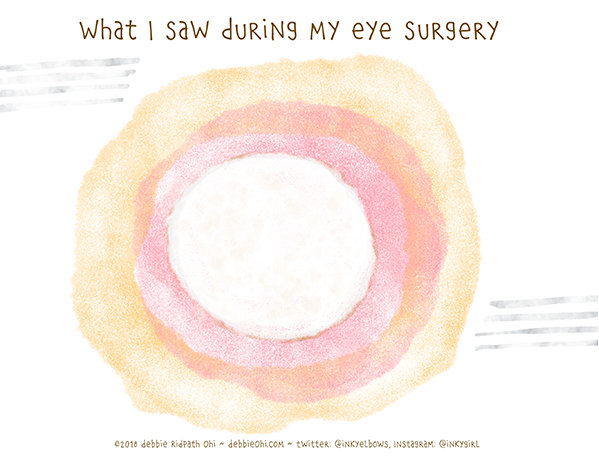
Also what helped a LOT: Dr. Lloyd’s calm, confident and reassuring manner as he told me what I would be feeling next. Examples (and please note I may not be remembering exact wording): “Ok, you’re going to feel some pressure for a little bit” and “you’re going to hear a buzzing sound” (I suspect the latter happened when my cataract was smooshed up via an ultrasonic device before being extracted) etc. I never felt caught off-guard by any of the sensations, and I always felt that my surgeon had everything under control, that everything was going exactly as planned.
The entire procedure was short (10-15 minutes for each eye) and pain-free. There were only a few brief bits of discomfort: what felt like tiny pinpricks at the corners of my eye (very brief and minimal) during prep, and when the surgical drape was removed from my face (like having masking tape lifted from your skin….again, very brief and minimal). I was mainly in floaty-land, almost enjoying the experience. I’m not exaggerating the last bit — compared to the laser surgery experience I had had when I had a subclinical detached retina years before, where there had been complications, this was nothing. I was giddy with relief (ok, maybe the little pill helped).
Dr. Lloyd told me that we were halfway done when my first eye was finished, to rest a moment while he went next door to do a post-op checkup, and that he’d be back soon. As I listened to the bustle of activity around me as others in the room prepped for the next stage of the surgery, I looked up at the ceiling light with my right eye and couldn’t help notice that even though my vision was still hazy post-op, I could see the grating across the light….something I never would be able to see without glasses before the surgery.
WOOHOO!!!!!
The second half of my surgery also went smoothly. There was no cataract in my left eye to smoosh up and extract, but the rest of the procedure was the same, I think – my old lens was replaced with a nice new lens. After the surgery was finished, Dr. Lloyd told me that I’d be taken to the waiting area to rest a bit, and then he’d do a post-op check to see how my eyes were doing.
Meanwhile, I was being helped to sit up, and I could immediately tell that my sight had improved. I knew it would be weeks before my eyes fully healed and sight settled, but WOW!!!!!! Even without glasses, I could see well enough to tell where everything and everyone was in the operating room. Usually (even before the cataract), everything was a blur if I wasn’t wearing my glasses – Jeff could be standing a couple of feet away and I would not be able to recognize him.
It was overwhelming and wonderful and life-changing. I fought the urge to cry because I knew that probably was not a good thing right after eye surgery. 🙂
I was given some dark glasses to wear and then was taken out to the waiting area, where Jeff was sitting. Jeff had brought me some food, and I scarfed it down before suddenly feeling super-tired, and apparently (Jeff says) fell asleep for around 20 minutes, leaning against his shoulder.
IGOR WAS FINALLY GONE!
Shortly after, I was called into one of the rooms for my post-op checkup. Dr. Lloyd examined my eyes to make sure everything was as it should be (it was) and gave me some post-op instructions. So glad that Jeff was there beside me, taking notes….I’m not sure how much I would have remembered. I couldn’t stop marveling at being able to SEE in a way I haven’t in a long time.
I’m still marvelling.
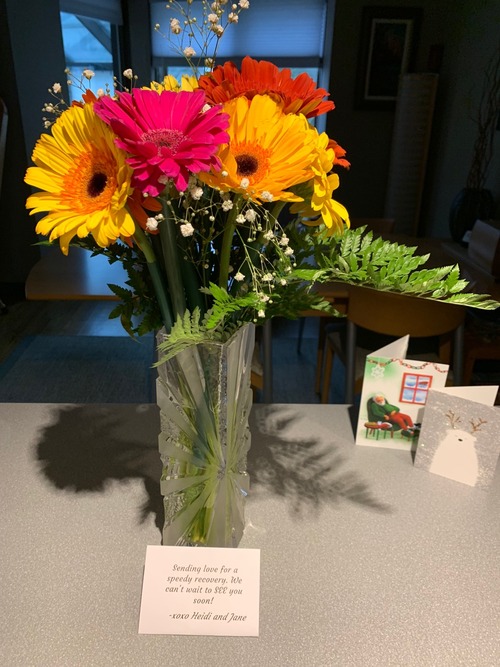
The day after my surgery, the flowers above arrived from my dear friend Heidi Stemple (Matthew Winner interviewed her this week!) and her mom, Jane Yolen (yes, THE Jane Yolen whose 365th book came out this year). SUCH a sweet surprise! I can’t stop admiring the flowers with new appreciation — colours are brighter now, and I also still can’t believe I can see these without glasses. Every time I visit the kitchen, I am compelled to stop and just LOOK. And see those two holiday cards in the back? The leftmost was created by Taia Morley (who also wished me well re: my upcoming surgery) and the one on the right is from one of my sisters-in-law and her family.
Thoughts, four days after surgery:
I started writing this post a week before my surgery on Monday, and have gradually been adding to it.
Today I had my first post-op appointment with Dr. Lloyd, and I got my prescription for distance glasses. It was my first time venturing out into the world since my surgery. I know I could have gone out earlier, but I really did not want to take chances with the early healing process, especially with potentially snow/slippery sidewalks outside, and me not yet having distance glasses yet (my computer screen/reading is crystal clear sans glasses because of the particular monofocal lenses I chose, but I’ll still need glasses to see more distant objects clearly).
And holy cow, what a difference. EVERYTHING WAS SO BRIGHT. In the grocery store, I found myself staring at the produce section, mesmerized. In the old days, this was because I kept imagining different types of produce in my found object art. Now, it’s also because EVERY SINGLE THING LOOKS AMAZING AND BEAUTIFUL.
I will also be wearing these Lasik shades while I’m outside for a few more days:
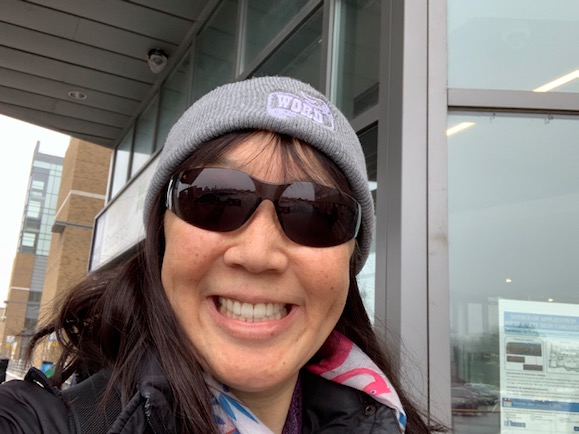
THANK YOU again to those who have sent supportive messages and encouragement. I did not post publicly about what was going on, partly because I wanted to wait to see how the surgery went and also because it has been more and more of a challenge to write this past year. Art has been somewhat easier because I can enlarge digital art on the computer screen to check details.
In terms of my professional circles, I’m especially grateful to my agent, Ginger Knowlton at Curtis Brown Ltd., and Simon & Schuster (esp my art director and editor) for their understanding and support — Laurent Linn and I talked on the phone about adjusted deadlines; I made sure to keep him in the loop early on as I worked on book illustrations. As for personal support, this would have been a much more difficult and complicated process had it not been for my husband, Jeff.
I also gained a new appreciation of services and efforts by those who want to help the visually impaired, as well as tools and tips for those who may need eye surgery like mine.
SOME THOUGHTS ON VISUAL IMPAIRMENT AND VISUAL MEDIA:
– While I do love print books, I have found print more and more of a challenge to read in the last couple of years. I did far more reading on my iPad, Kindle and iPhone — the backlighting and ability to enlarge type was a huge help. E-books are just as valid a way of reading as print books. They may not be as satisfying to hold and turn pages etc., but they made it possible for me to keep reading. I still bought some print books to support indie bookstores as well as my author and illustrator friends, but for books like novels I often ALSO bought a digital version that I could read on my iPad.
I also read a lot of books via audiobook format, and learned an appreciation for good narrators.
– Because I wasn’t sure how my vision would be after the surgery, I also did some research about what movies, TV series and documentaries have an audio description for those who are visually impaired, and found this list of programs which are audio-described in English on the USA Netflix, created by the American Council Of The Blind. I’ve been “watching” The Crown this way as an alternative to audiobooks, and have also become more curious about how students who are visually impaired access books, how visual description might benefit students without visual impairments, and more info about audio description for visually impaired viewers.
– I’ve also been doing a lot of thinking about individual visual perception, especially when I was trying to describe or show what my cataract-ridden vision was doing. I wasn’t aware of how much colours had changed, for example (I know part of that was my aging eyes as well, but the cataract definitely had an impact). What looks bright blue to me may not look the same to someone else. Low contrast illustrations may be more difficult for people with some visual limitations to enjoy.
I hated Igor in the beginning but now that he’s gone, I suppose a little part of me is grateful to him for helping me better appreciate the world around me as well as make me think more deeply about visual perception and ways to cope with the lack thereof.
So much more, but this post has already run long enough.
Plus OMIGOSH…. Now that it’s sooooo much easier for me to write and draw, I can’t wait to dive back into creative work.
2019, HERE I COME!!!
————————
SOME RESOURCES YOU MIGHT FIND USEFUL OR THAT I MENTIONED IN THIS POST:
Info about my eye surgeon, Dr. John Lloyd, on the Lasik MD website
Trading Places: A Cataract Surgeon’s Personal Experience With Cataract Surgery
Cataract Surgery by Vance Thompson, MD on AllAboutVision.com.
The Audio Description Project: An initiative of the American Council Of The Blind.
How Does Description Benefit Students Without Visual Impairments?: on ListeningIsLearning.com.
Audio Description For Blind Viewers: On Wonderbaby.org.
————————
FINAL REMINDER: I created this post because it’s the kind of personal viewpoint I was hoping to find while researching for my own eye surgery. Please note that every situation is different – talk to a medical expert before making your own decisions. I am NOT a medical expert, and also may have gotten some of the terminology/details wrong. I also have found that these kinds of blog posts tend to generate emails from people in the longterm, asking me for advice — while I’m happy to offer any personal experience insights that are not covered above, I will not give any medical advice. Please ask your doctor or opthamologist, thanks. ]

